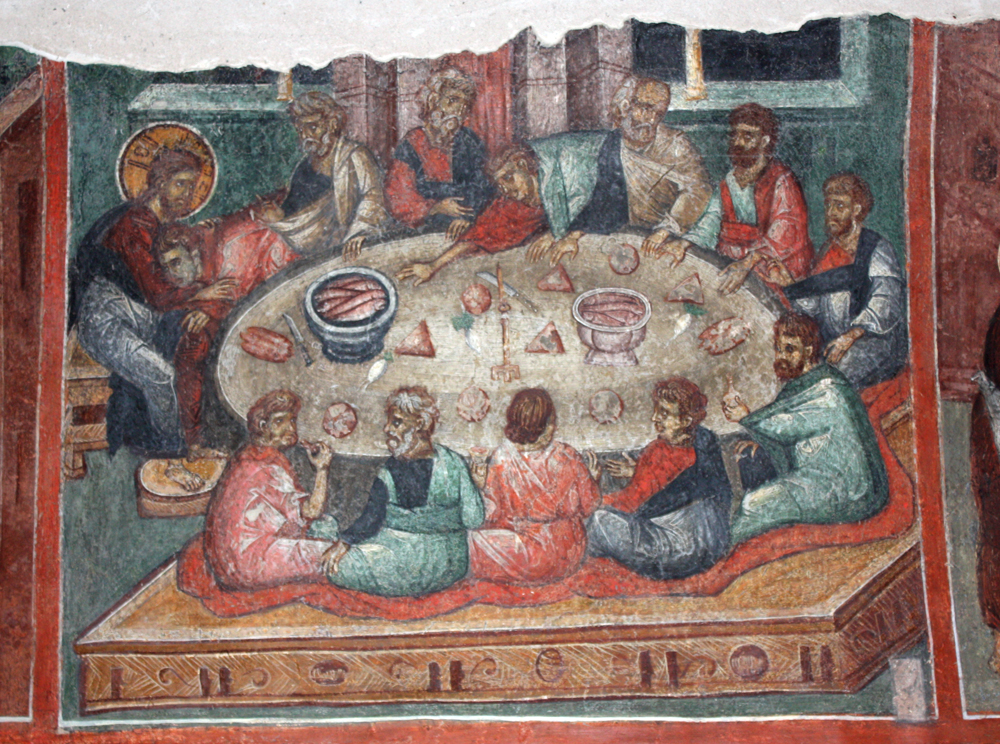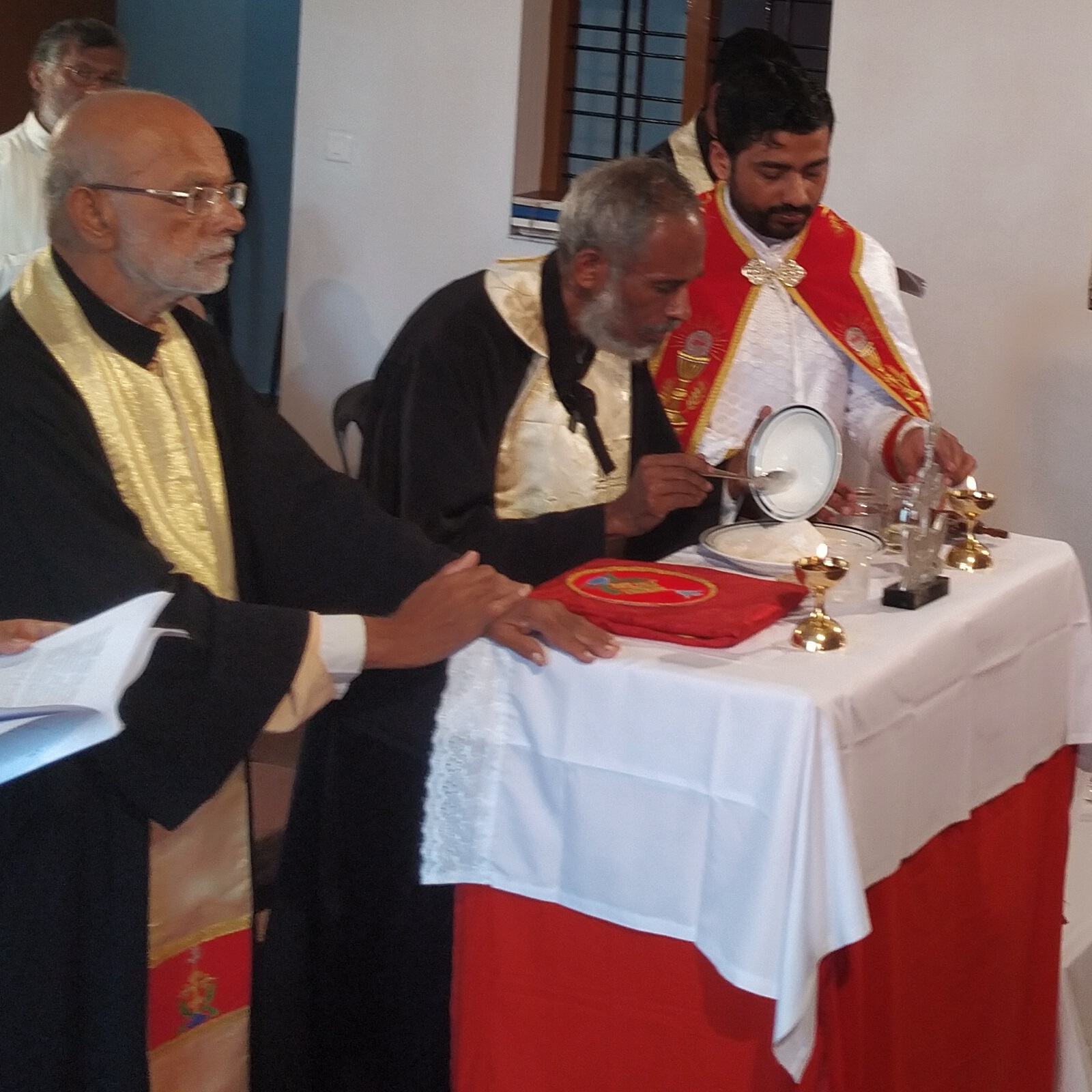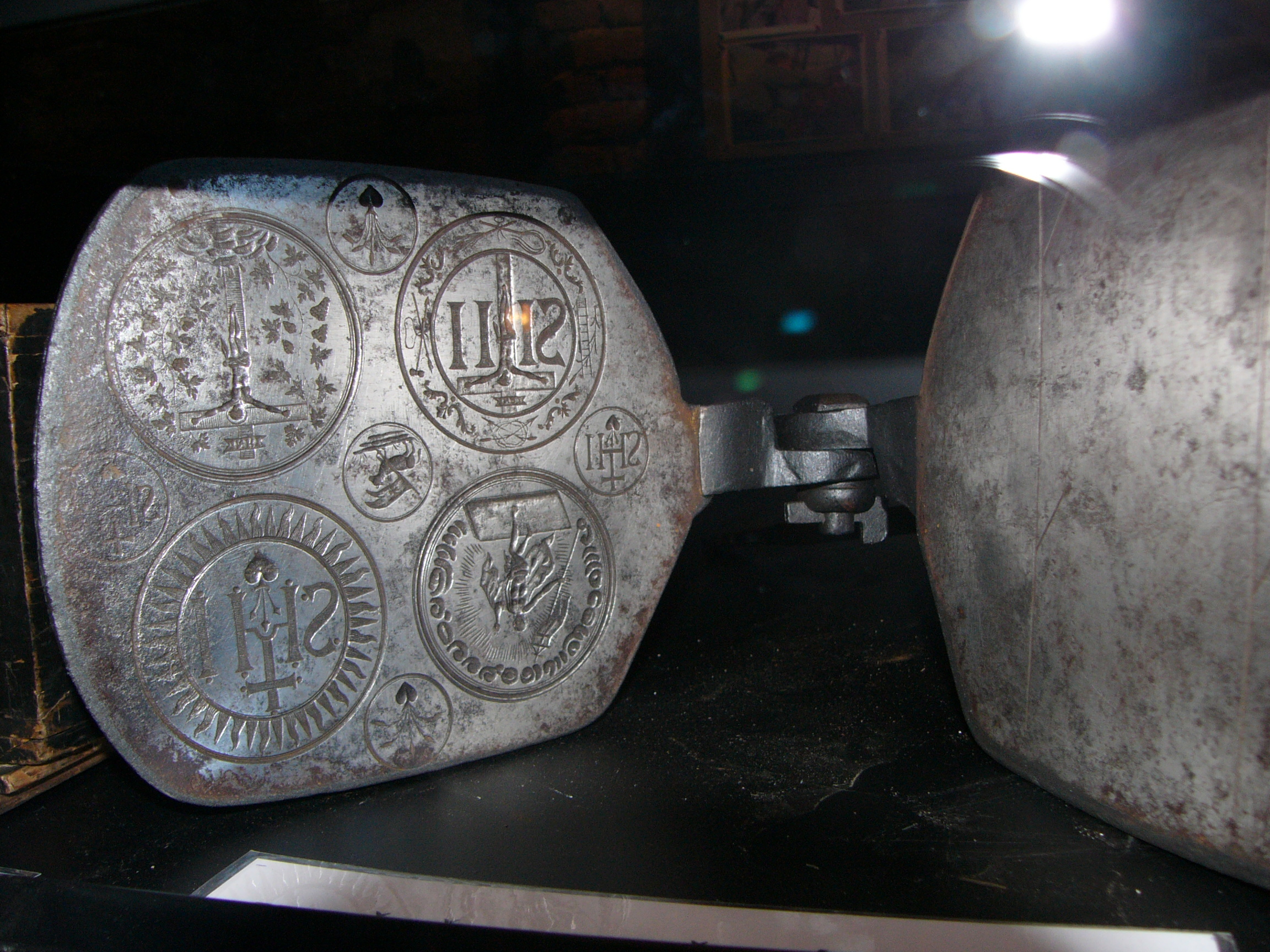|
Fatira
In Mandaeism, faṭira (; plural form: ''faṭiri''Drower, Ethel Stefana. 1937. ''The Mandaeans of Iraq and Iran''. Oxford At The Clarendon Press.) is a small, round, saltless, half-baked biscuit. Faṭiras are used in rituals such as the Ṭabahata Masiqta, or the "masiqta of the Parents," during which they are served in ritual clay trays called ''ṭariana''. The faṭira, which is saltless, is distinct from another type of sacramental bread known as the ''pihta'', which contains salt to symbolize the souls of living people when used for living celebrants, but is saltless like the faṭira when used during masiqta (death mass) rituals. The ''qina'' is a pile of faṭiras where ritual food morsels are placed for use in masiqta rituals. The '' ṣa'' (), a rolled-up piece of sacramental flatbread that contains nuts and raisins, is also used in ritual meals for the dead and has a phallic symbolism. It is rolled up like a scroll. See also *Sacramental bread *Pihta In Mandaeis ... [...More Info...] [...Related Items...] OR: [Wikipedia] [Google] [Baidu] |
Pihta
In Mandaeism, the pihta () is a type of sacramental bread used with rituals performed by Mandaean priests. It is a small, round, biscuit-sized flatbread that can either be salted or saltless, depending on whether the ritual use of the pihta is for living or dead people. The pihta is not to be confused with the '' faṭira'', a small, round, saltless, half-baked biscuit also used in Mandaean rituals. Description The pihta, as used in rituals for living people such as the masbuta, is a small, round, salted, biscuit-sized flatbread made by mixing flour and salt with water, followed by baking. It can only be made by Mandaean priests, and the flour is also ground by priests.Drower, Ethel Stefana. 1937. ''The Mandaeans of Iraq and Iran''. Oxford At The Clarendon Press. Unlike the '' faṭira'', which is saltless sacramental bread used for the masiqta, the pihta (as used in masbuta rituals) is salted (with salt mixed into the dough before baking), since salt (''mihla'') represents ... [...More Info...] [...Related Items...] OR: [Wikipedia] [Google] [Baidu] |
Sa (Mandaeism)
In Mandaeism, the ṣa () is a rolled-up piece of sacramental flatbread that contains nuts and raisins, is also used in ritual meals for the dead and has a phallic symbolism. It is a small round flap of unleavened bread that is rolled up like a scroll.Drower, Ethel Stefana. 1937. ''The Mandaeans of Iraq and Iran''. Oxford At The Clarendon Press. It is distinct from the pihta and faṭira, which are flatbreads that are not rolled up. The ''ṣa'' is also mentioned as the 'great first ''sindirka'' (male date-palm)' in the '' Scroll of the Great Baptism'' (line 139 f.). See also *Sacramental bread *Pihta *Fatira In Mandaeism, faṭira (; plural form: ''faṭiri''Drower, Ethel Stefana. 1937. ''The Mandaeans of Iraq and Iran''. Oxford At The Clarendon Press.) is a small, round, saltless, half-baked biscuit. Faṭiras are used in rituals such as the Ṭaba ... References Flatbreads Mandaean ceremonial food and drink Mandaic words and phrases Eucharistic objects Unleave ... [...More Info...] [...Related Items...] OR: [Wikipedia] [Google] [Baidu] |
Pihta
In Mandaeism, the pihta () is a type of sacramental bread used with rituals performed by Mandaean priests. It is a small, round, biscuit-sized flatbread that can either be salted or saltless, depending on whether the ritual use of the pihta is for living or dead people. The pihta is not to be confused with the '' faṭira'', a small, round, saltless, half-baked biscuit also used in Mandaean rituals. Description The pihta, as used in rituals for living people such as the masbuta, is a small, round, salted, biscuit-sized flatbread made by mixing flour and salt with water, followed by baking. It can only be made by Mandaean priests, and the flour is also ground by priests.Drower, Ethel Stefana. 1937. ''The Mandaeans of Iraq and Iran''. Oxford At The Clarendon Press. Unlike the '' faṭira'', which is saltless sacramental bread used for the masiqta, the pihta (as used in masbuta rituals) is salted (with salt mixed into the dough before baking), since salt (''mihla'') represents ... [...More Info...] [...Related Items...] OR: [Wikipedia] [Google] [Baidu] |
Eucharistic Objects
The Eucharist ( ; from , ), also called Holy Communion, the Blessed Sacrament or the Lord's Supper, is a Christian rite, considered a sacrament in most churches and an ordinance in others. Christians believe that the rite was instituted by Jesus at the Last Supper, the night before his crucifixion, giving his disciples bread and wine. Passages in the New Testament state that he commanded them to "do this in memory of me" while referring to the bread as "my body" and the cup of wine as "the blood of my covenant, which is poured out for many". According to the synoptic Gospels, this was at a Passover meal. The elements of the Eucharist, sacramental bread, either leavened or unleavened, and sacramental wine (non-alcoholic grape juice in some Protestant traditions, such as Methodism), are consecrated on an altar or a communion table and consumed thereafter. The consecrated elements are the end product of the Eucharistic Prayer. Christians generally recognize a special prese ... [...More Info...] [...Related Items...] OR: [Wikipedia] [Google] [Baidu] |
Mandaeism
Mandaeism (Mandaic language, Classical Mandaic: ),https://qadaha.wordpress.com/wp-content/uploads/2021/03/nhura-dictionary-mandaic-english-mandaic.pdf sometimes also known as Nasoraeanism or Sabianism, is a Gnosticism, Gnostic, Monotheism, monotheistic and ethnic religion with Ancient Greek religion, Greek, Iranian religions, Iranian, and Judaism, Jewish influences. Its adherents, the Mandaeans, revere Adam#In Mandaeism, Adam, Abel#Mandaean interpretation, Abel, Seth#Mandaeism, Seth, Enos (biblical figure)#In Mandaeism, Enos, Noah#Mandaeism, Noah, Shem#In Mandaeism, Shem, Aram, son of Shem, Aram, and especially John the Baptist#Mandaeism, John the Baptist. Mandaeans consider Adam, Seth, Noah, Shem, and John the Baptist prophets, with Adam being the founder of the religion and John being the greatest and Last prophet, final prophet. The Mandaeans speak an Eastern Aramaic languages, Eastern Aramaic language known as Mandaic language, Mandaic. The name 'Mandaean' comes from th ... [...More Info...] [...Related Items...] OR: [Wikipedia] [Google] [Baidu] |
Ṭabahata Masiqta
The ''Scroll of the Ancestors'' ( ) is a Mandaean religious text that describes the rituals of the Ṭabahata (ancestors') masiqta, held during the 5-day Parwanaya festival. Manuscripts Copies of the scroll include Manuscript 42 of the Drower Collection (DC 42), currently held at the Bodleian Library. The scroll was originally transcribed in 1743 and has 834 lines. It is similar to Prayer 170 of the Qulasta, but some names are different. DC 42 verso, copied at Basra in 1248 A.H. (1832–3 A.D.), contains six texts: *''Šarḥ ḏ-ahaba ḏ-mania b-iuma ḏ- paruanaiia'' *''Aprišata ḏ-ahaba ḏ-mania'' *''Šarḥ ḏ-ahaba ḏ-mania ḏ-tarmida ʿu ganzibra kḏ napiq'' *''Šarḥ ḏ-ṭabahata qria b-šuma ḏ-gabrauʿnta'' *''Šarḥ ḏ-dukrana ḏ-šumaiia'' *''Šarḥ ḏ- zidqa brika ḏ- paruanaiia'' Ṭabahata Masiqta The Ṭabahata Masiqta, or the "masiqta of the Parents", is held only once a year during the Parwanaya intercalary festival. Priests recite dozen ... [...More Info...] [...Related Items...] OR: [Wikipedia] [Google] [Baidu] |
Masiqta
The masiqta () is a mass or ritual practiced in the Mandaean religion in order to help guide the soul ('' nišimta'') towards the World of Light in Mandaean cosmology. They are typically performed as funerary rites for Mandaeans who have just died. Although usually translated as "death mass", a few types of ''masiqta'' are also performed for living people, such as when priests are ordained. Masiqtas are also used to consecrate houses of worship ('' bit manda''). Purpose The complex ritual involves guiding the soul through the '' maṭarta'', or toll houses located between the Earth ( Tibil) and the World of Light, which are guarded by various uthras and demons. A successful masiqta merges the incarnate soul ( ; roughly equivalent to the '' psyche'' or " ego" in Greek philosophy) and spirit ( ; roughly equivalent to the ''pneuma'' or "breath" in Greek philosophy) from the Earth ( Tibil) into a new merged entity in the World of Light called the ''ʿuṣṭuna''. The ''ʿuṣṭun ... [...More Info...] [...Related Items...] OR: [Wikipedia] [Google] [Baidu] |
Sacramental Bread
Sacramental bread, also called Communion bread, Communion wafer, Sacred host, Eucharistic bread, the Lamb or simply the host (), is the bread used in the Christian ritual of the Eucharist. Along with sacramental wine, it is one of two elements of the Eucharist. The bread may be either leavened or unleavened, depending on tradition. Catholic theology generally teaches that at the Words of Institution the bread's substance is changed into the Body of Christ, a process known as transubstantiation. Conversly, Eastern Christian theology generally views the epiclesis as the point at which the change occurs. Christianity Etymology of ''host'' The word ''host'' is derived from the Latin , which means 'sacrificial victim'. The term can be used to describe the bread both before and after consecration, although it is more correct to use it after consecration. Eastern traditions With the exception of Churches of the Armenian Rite, the Maronite Church, and the Syro-Malabar Church, ... [...More Info...] [...Related Items...] OR: [Wikipedia] [Google] [Baidu] |
Flatbread
A flatbread is bread made usually with flour; water, milk, yogurt, or other liquid; and salt, and then thoroughly rolled into flattened dough. Many flatbreads are Unleavened bread, unleavened, although some are leavened, such as pita bread. A Serving size, serving of 85g (~3 ounces) of pita bread has 234 Calorie, calories. Flatbreads range from below one millimeter to a few centimeters thick so that they can be easily eaten without being sliced. They can be baked in an oven, fried in hot oil, grilled over hot coals, cooked on a hot pan, tava, Comal (cookware), comal, or metal griddle, and eaten fresh or packaged and frozen for later use. History Flatbreads were amongst the earliest food processing, processed foods, and evidence of their production has been found at ancient sites in Mesopotamia, ancient Egypt, and the Indus Valley Civilisation, Indus civilization. The origin of all flatbread baking systems are said to be from the Fertile Crescent in West Asia, where they would su ... [...More Info...] [...Related Items...] OR: [Wikipedia] [Google] [Baidu] |
Phallic Symbolism
A phallus (: phalli or phalluses) is a penis (especially when erect), an object that resembles a penis, or a mimetic image of an erect penis. In art history, a figure with an erect penis is described as ''ithyphallic''. Any object that symbolically—or, more precisely, iconically—resembles a penis may also be referred to as a phallus; however, such objects are more often referred to as being phallic (as in "phallic symbol"). Such symbols often represent fertility and cultural implications that are associated with the male sexual organ, as well as the male orgasm. Etymology The term is a loanword from Latin ''phallus'', itself borrowed from Greek (''phallos''), which is ultimately a derivation from the Proto-Indo-European root *''bʰel''- "to inflate, swell". Compare with Old Norse (and modern Icelandic) ''boli'', "bull", Old English ''bulluc'', "bullock", Greek , "whale". Archaeology The Hohle phallus, a 28,000-year-old siltstone phallus discovered in the Hohle Fels c ... [...More Info...] [...Related Items...] OR: [Wikipedia] [Google] [Baidu] |
Sacramental Bread
Sacramental bread, also called Communion bread, Communion wafer, Sacred host, Eucharistic bread, the Lamb or simply the host (), is the bread used in the Christian ritual of the Eucharist. Along with sacramental wine, it is one of two elements of the Eucharist. The bread may be either leavened or unleavened, depending on tradition. Catholic theology generally teaches that at the Words of Institution the bread's substance is changed into the Body of Christ, a process known as transubstantiation. Conversly, Eastern Christian theology generally views the epiclesis as the point at which the change occurs. Christianity Etymology of ''host'' The word ''host'' is derived from the Latin , which means 'sacrificial victim'. The term can be used to describe the bread both before and after consecration, although it is more correct to use it after consecration. Eastern traditions With the exception of Churches of the Armenian Rite, the Maronite Church, and the Syro-Malabar Church, ... [...More Info...] [...Related Items...] OR: [Wikipedia] [Google] [Baidu] |
Mandaean Ceremonial Food And Drink
{{disambig ...
Mandean or Mandaean may refer to: * Mandaeism, a Gnostic religion * Mandaeans, the ethnoreligious group who follow the Gnostic religion * Mandean, the language family in West Africa known as the Mande languages See also * Mandaic (other), the variety of Aramaic and its alphabet used by the Mandaeans * Mande (other) Mande may refer to: * Mandé peoples of western Africa * Mande languages, their Niger-Congo languages * Manding languages, Manding, a term covering a subgroup of Mande peoples, and sometimes used for one of them, Mandinka people, Mandinka * Garo p ... [...More Info...] [...Related Items...] OR: [Wikipedia] [Google] [Baidu] |






